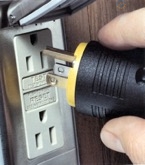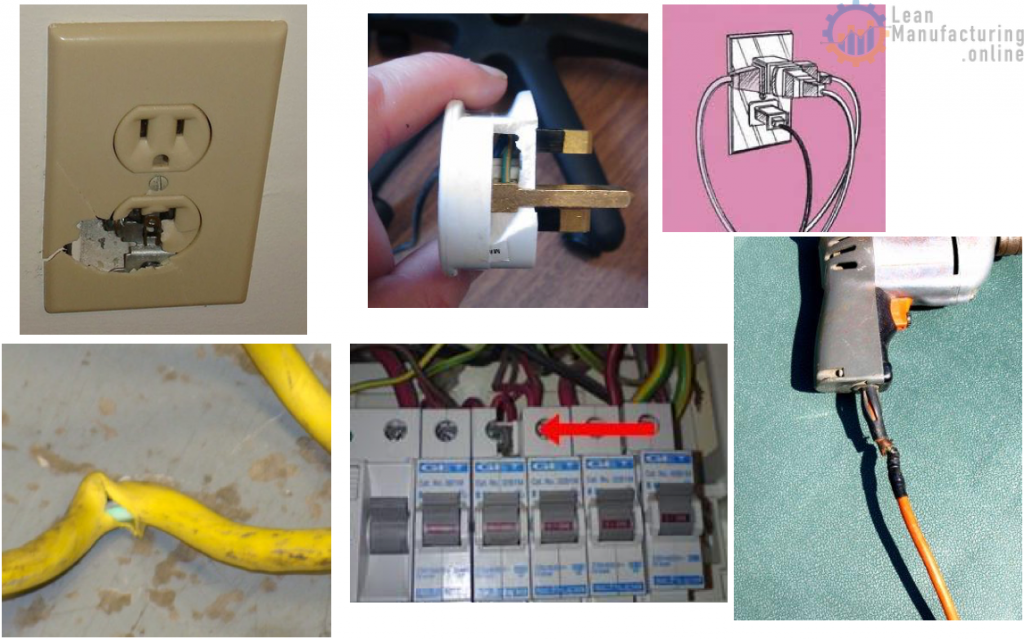The Basics
- Electricity flows more easily through some materials than others.
- Conductor – substances that offer little resistance (metal, earth surface)
- Insulator – Substances that slow down or stop flow of electricity (glass, porcelain, wood)
When a person receives an electrical shock, sometimes the electrical stimulation causes the muscles to contract. This “freezing” effect makes the person unable to pull free of the circuit. It is extremely dangerous because it increases the length of exposure to electricity and because the current causes blisters, which reduce the body’s resistance and increases the current. In addition to muscle contractions that cause “freezing,” electrical shocks also can cause involuntary muscle reactions. These reactions can result in a wide range of other injuries from collisions or falls, including bruises, bone fractures, and even death.
Statistics
- An average of one worker is electrocuted on the job every day;
- There are four main types of electrical injuries:
- Electrocution (death due to electrical shock);
- Electrical shock;
- Burns;
- Falls.
Electrical Shock
A small current that passes through the trunk of the body (heart and lungs) is capable of causing severe injury or electrocution. Low voltages can be extremely dangerous because, all other factors being equal, the degree of injury increases the longer the body is in contact with the circuit.
- Received when current passes through the body;
- Severity of the shock depends on:
- Path of current through the body;
- Amount of current flowing through the body;
- Length of time the body is in the circuit
Electrical Burns


- Most common shock-related, nonfatal injury;
- Occurs when you touch electrical wiring or equipment that is improperly used or maintained;
- Typically occurs on the hands;
- Very serious injury that needs immediate attention.
Falls related to Electric shock

- Electric shock can also cause indirect or secondary injuries;
- Workers in elevated locations who experience a shock can fall, resulting in serious injury or death.
Grounding Path

The path to ground from circuits, equipment, and enclosures must be permanent and continuous.
Hand-Held Electric Tools

- Hand-held electric tools pose a potential danger because they make continuous good contact with the hand;
- To protect you from shock, burns, and electrocution, tools must:
- Have a three-wire cord with ground and be plugged into a grounded receptacle, or
- Be double insulated, or
- Be powered by a low-voltage isolation transformer.
Work practices CAN help protect you against electrical hazards!
Electrical accidents are largely preventable through
safe work practices.
Examples of these practices include the following:
- De-energizing electrical equipment before inspection or repair (Lock Out Tag Out)
- keeping electric tools properly maintained,
- exercising caution when working near energized lines,
- Follow “Left – Hand Rule”
- And using appropriate protective equipment.
Training
Train employees working with electric equipment in safe work practices, including:
- De-energizing electric equipment before inspecting or making repairs;
- Using electric tools that are in good repair;
- Using good judgment when working near energized lines;
- Using appropriate protective equipment.
Arc flash training can be found here
Example of Electrical One Point Lesson can be reviewed here
Autonomous Maintenance training module can be seen here
Electrical Equipment Defects
- Maintain equipment and appliances through regular inspection. Look for any damage such as flickering, smoke, popping, excessive heat etc;
- Disconnect broken appliances and have broken power points or frayed cords replaced immediately;
- Know the location of the main electricity supply in case of emergency;
- Keep electrical appliances away from water and wet areas. Never touch switches or power points with wet/damp hands;
- Don’t overload circuits and fuses by using too many appliances from the one power point;
- Keep electrical cords off the floor to reduce the risk of damage from contact with sharp object.

Reporting Electrical Defects
- Take the equipment out of service.
- Fill out / complete a safety tag. Clearly describe defect.
- Ensure that you a copy of the tag is personally handed to your Supervisor.
- If there is immediate danger to life: STOP WORK, LOTO and inform your Supervisor.
Summary
Hazards
- Inadequate wiring
- Exposed electrical parts
- Wires with bad insulation
- Ungrounded electrical systems and tools
- Overloaded circuits
- Damaged power tools and equipment
- Using the wrong PPE and tools
- Overhead powerlines
- All hazards are made worse in wet conditions
Protective Measures
- Proper grounding
- Using GFCI’s (Ground Fault Circuit Interrupters)
- Using fuses and circuit breakers
- Guarding live parts
- Proper use of flexible cords
- Training
This Training is only for reference – always follow safety rules prescribed by your local H&S department.















